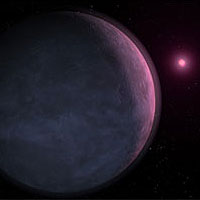Doodling Shake Bot DIY STEM Kit
$9.99$5.95
Posted on: Jun 2, 2008

Astronomers have discovered an extrasolar planet only three times more massive than our own, the smallest yet observed orbiting a normal star. The star itself is not large, perhaps as little as one twentieth the mass of our Sun, suggesting to the research team that relatively common low-mass stars may present good candidates for hosting Earth-like planets.
Led by David Bennett of the University of Notre Dame, the international research team presents its findings in a press conference Monday, June 2, 2008, at 11:30 a.m. CDT at the American Astronomical Society Meeting in St. Louis, Mo.
'Our discovery indicates that that even the lowest mass stars can host planets,' says Bennett. 'No planets have previously been found to orbit stars with masses less than about 20 percent that of the Sun, but this finding indicates that even the smallest stars can host planets.'
The astronomers used a technique called gravitational microlensing to find the planet, a method that can potentially find planets one-tenth the mass of our own.
The gravitational microlensing technique, which came from Einstein's General Theory of Relativity, relies upon observations of stars that brighten when an object such as another star passes directly in front of them (relative to an observer, in this case on Earth). The gravity of the passing star acts as a lens, much like a giant magnifying glass. If a planet is orbiting the passing star, its presence is revealed in the way the background star brightens. A full explanation of the technique follows this release.
'This discovery demonstrates the sensitivity of the microlensing method for finding low-mass planets, and we are hoping to discover the first Earth-mass planet in the near future,' said Bennett.
Using standard nomenclature, the star hosting the newly discovered planet is dubbed MOA-2007-BLG-192L with MOA indicating the observatory, 2007 designating the year the microlensing event occurred, BLG standing for bulge, 192 indicating the 192nd microlensing observation by MOA in that year and the L indicating the lens star as opposed to the background star further in the distance. The planet maintains the name but adds a letter designating it as an additional object in the star's solar system, so it is called MOA-2007-BLG-192Lb.
MOA-2007-BLG-192L resides 3,000 light years away and is classified as either a low-mass hydrogen burning star, one that sustains nuclear reactions in its core as our Sun does, or a brown dwarf, an object like a star yet without the mass to sustain nuclear reactions in its core. The researchers were unable to confirm which category the star fits into due to the nature of the observations and the margin of error.
With support from the National Science Foundation (NSF), Bennett has been one of the pioneers in using gravitational microlensing for detecting low mass planets. He has been working with collaborators around the world to find a number of planets that are ever closer in size to our own.
For the most recent discovery, the research collaborators took advantage of two international telescope collaborations: Microlensing Observations in Astrophysics (MOA), which includes Bennett, and the Optical Gravitational Lensing Experiment (OGLE).
Researchers in New Zealand made the initial measurements of the new planet and its star using the new MOA-II telescope at the Mt. John Observatory. The observatory's MOA-cam3 camera, in one observation, can capture an image of the sky 13 times larger than the area of the full moon. Researchers in Chile made follow-up observations using high angular resolution adaptive optics images at the Very Large Telescope at the European Southern Observatory. Data from the observations was analyzed by scientists around the world hailing from five continents.
'This discovery is very exciting because it implies Earth-mass planets can form around low-mass stars, which are very common,' said Michael Briley, NSF astronomer and the officer who oversees Bennett's grant. 'It is another important step in the search for terrestrial planets in the habitable zones of other stars, and it would not have been possible without the international collaboration of professional and amateur astronomers devoted to measuring these signals.'
The team has written a paper about the new planet discovery and it has been accepted for publication in the Sept. 1, 2008, issue Astrophysical Journal. In addition to NSF support, Bennett is also funded by the National Aeronautics and Space Administration.
In addition to Bennett, the MOA group is made up of astronomers from Nagoya University, Konan University, Nagano National College of Technology, and Tokyo Metropolitan College of Aeronautics in Japan, as well as Massey University, the University of Auckland, Mt. John Observatory, the University of Canterbury, and Victoria University in New Zealand. The OGLE group is comprised of astronomers from Warsaw University Observatory in Poland, the Universidad de Concepción in Chile, and the University of Cambridge in England. Additional collaborators who provided the VLT data and analysis are from the Institut d'Astrophysique de Paris, the Observatoire Midi-Pyrénées, and the Observatoire de Paris in France, the European Southern Observatory in Chile, and Heidelberg University in Germany.
 'The atomic bomb ... made the prospect of future war unendurable. It has led us up those last few steps to the mountain pass; and beyond there is different country.'
'The atomic bomb ... made the prospect of future war unendurable. It has led us up those last few steps to the mountain pass; and beyond there is different country.'